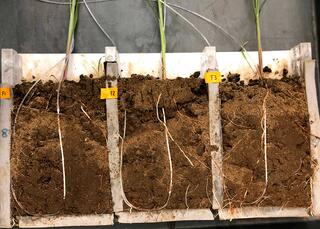Mixed signals: Plant chemicals have varied effects on root system microbes

Understanding the role of terpenes and terpenoids could help scientists design crops that can resist diseases with fewer pesticides.
The Science
Terpenes and variations called terpenoids are chemicals produced by many plants that are responsible for distinctive scents and flavors. Terpenes also serve as signaling molecules that interact with the plant’s environment. For example, they may attract pollinators or repel pests. Here, scientists sought to understand how terpenes and terpenoids affect the bacteria and fungi that live around the roots of two plant species, switchgrass and sorghum. The results showed terpenes and terpenoids have variable effects on specific microbes depending on the compound, location, and timing.
The Impact
Plans to slow climate change call for increased use of plant-based fuels and chemicals to replace fossil fuels and petrochemicals. Switchgrass and sorghum are grasses that tolerate heat and drought and can grow on marginal land with little fertilizer or other inputs. Because they produce a lot of biomass and store carbon in the soil, these plants are considered sustainable sources of biofuels and products. Understanding the role of terpenes and terpenoids could help scientists breed or engineer crops that grow bigger and that attract helpful microbes while resisting diseases brought about by climate change with fewer pesticides.
Summary
In a pair of new studies, scientists with the Great Lakes Bioenergy Research Center assessed the impact of terpenes and terpenoids on bacterial and fungal isolates and communities in the area around the root systems of switchgrass and sorghum.
One study focused on abundant terpenoids that differ dramatically in the root metabolomes among switchgrass ecotypes. Researchers found that root extracts from upland and lowland switchgrass varieties inhibit fungal growth differently based on the amount of two plant chemicals, steroidal saponins and diterpenoids. Saponins with sugar groups attached at a single position inhibited growth, while those with sugars attached at two positions did not. Modifications to the saponin core were also associated with reduced activity. Strong diterpenoid antifungal activity was associated with the presence of an intact furan ring.
In the other study, researchers designed an experiment to assess how belowground exogenous applications of monoterpenes (1,8-cineole and linalool) and a sesquiterpene (nerolidol) delivered through an artificial root system impacted its belowground bacterial and fungal microbiome. Results showed terpene applications had significant and variable impacts on bacterial and fungal communities, depending on terpene class and concentration; however, impacts were localized to the artificial root system and the fungal rhizosphere. Assays on pure fungal and bacterial isolates showed differential impacts of terpenes on microbial growth depending on dose, compound, and microbe.
Together, these results inform future breeding and biotechnology strategies for optimizing crop microbiomes for growth, health, and protection with reduced pesticide application.
Contact
Greg Bonito
Michigan State University
bonito@msu.edu